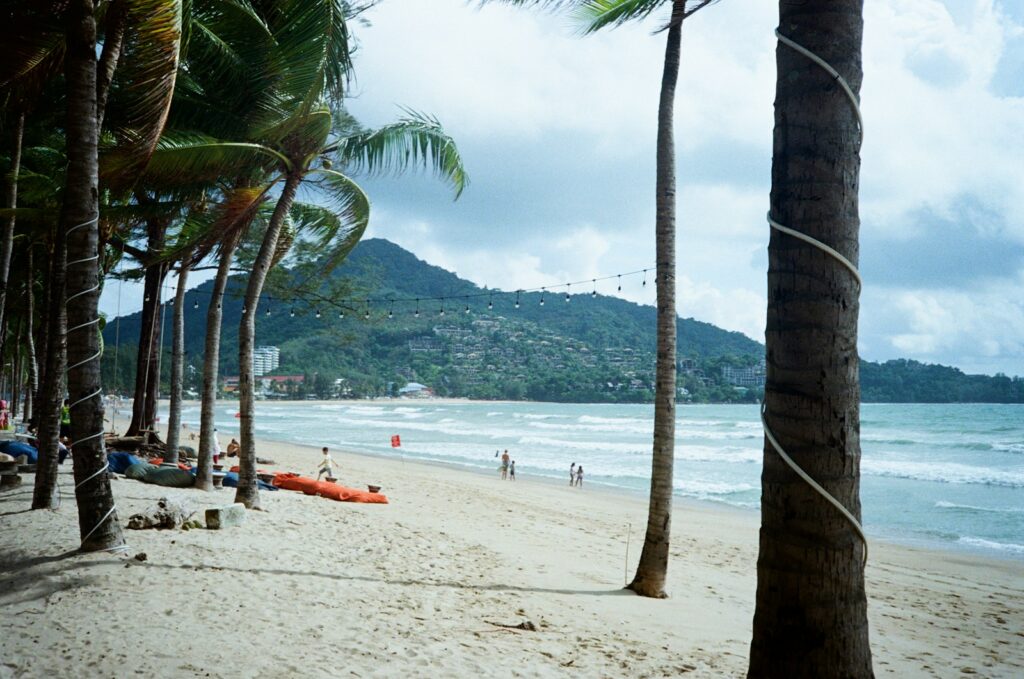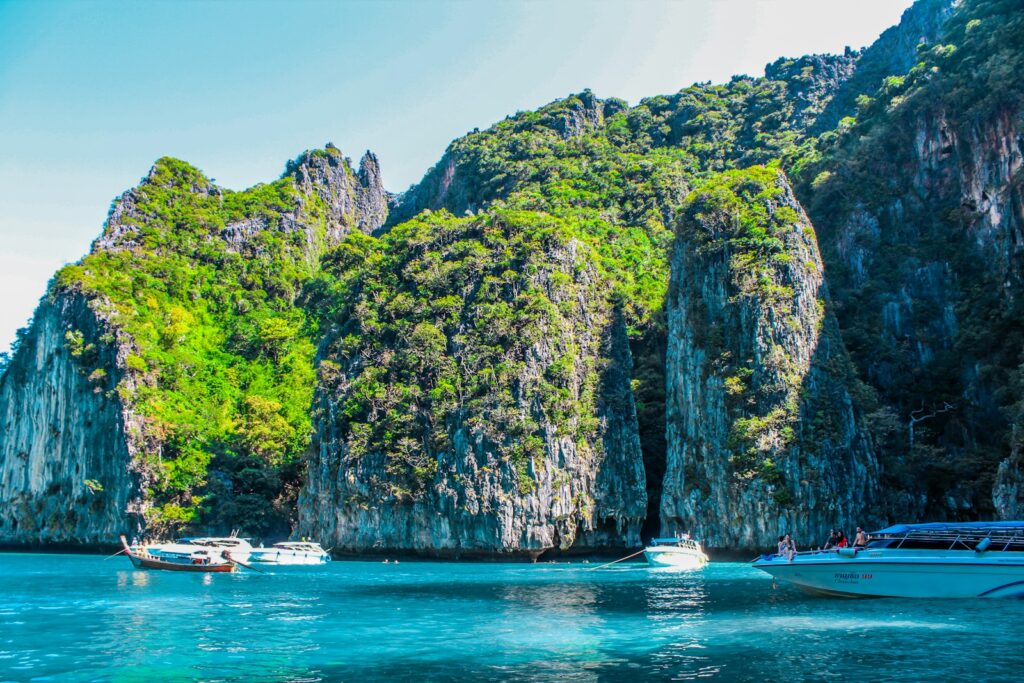
As a traveler with a passion for exploration, Thailand offers an endless array of fascinating destinations. From bustling cities to serene beaches, this Southeast Asian gem is perfect for your next adventure. Thailand’s diverse landscapes, rich culture, and incredible food scene make it an irresistible destination for photographers, adventurers, and food lovers alike.
In this guide, I’ll walk you through the five best places to visit in Thailand, the ideal time of year to experience them, and how to get there from Australia. You’ll also learn about visa restrictions, language considerations as an English speaker, and the best dining options. Additionally, I’ll provide accessibility information to ensure smooth travels for you or any companions with mobility concerns. As a bonus, I’ll share an insider tip that will elevate your Thailand experience even further.
Bangkok: The Thrilling Capital of Thailand
Why visit?
Bangkok, the vibrant capital of Thailand, is a city that never sleeps. It’s an ideal starting point for any Thai adventure. The city’s fusion of traditional temples, lively markets, and futuristic skyscrapers makes it a playground for photographers and explorers. Visit the Grand Palace, Wat Arun (Temple of Dawn), or take a scenic boat ride along the Chao Phraya River.
Best Time to Visit
The best time to visit Bangkok is between November and February, during the cool season. You’ll experience pleasant temperatures and lower humidity, making outdoor exploration much more comfortable. These months are perfect for wandering the city’s streets without the intense heat or heavy rain.
Accessibility
Bangkok is increasingly becoming more accessible, with many of its main attractions working to accommodate travelers with limited mobility. The Grand Palace and Wat Pho offer wheelchair rentals and accessible pathways. Additionally, the city’s Skytrain (BTS) and subway (MRT) systems are expanding their accessibility features, including elevators and ramps at many stations.
Food options
Jay Fai, Bangkok’s famous Michelin-starred street food stall offers incredible crab omelets and stir-fried dishes. Be prepared for a queue, but the wait is worth it. For a more upscale experience, Bo.lan serves authentic Thai cuisine using local and sustainable ingredients in a fine dining setting.
Chiang Mai: A Gateway to Thailand’s Cultural Heritage
Why visit?
Located in northern Thailand, Chiang Mai is known for its rich cultural history, stunning temples, and laid-back atmosphere. This city is the perfect contrast to the bustling energy of Bangkok. Visit the famous Wat Phra Singh or climb the 300 steps to Wat Phra That Doi Suthep for breathtaking views of the city and the surrounding mountains. Chiang Mai’s night markets are also a haven for food lovers and those looking to shop for unique souvenirs.
Accessibility
Chiang Mai is relatively accessible, but some of its older temples and markets can pose challenges for travelers with mobility issues. However, many accommodations, restaurants, and tourist services offer accessible options. For example, the Chiang Mai Night Safari is fully accessible, and several tour companies offer wheelchair-friendly transportation.
Food options
For an authentic northern Thai dish, try Khao Soi, a flavorful coconut curry noodle soup, found at Khao Soi Khun Yai. Or if you are in the mood for a restaurant that has western options as well as Thai, head to the Riverside Bar & Restaurant. Not only will you have a great meal but also have a view of the beautiful Ping River.
Phuket: Thailand’s Famous Island Paradise

Why visit?
Phuket is Thailand’s largest island and a premier destination for beach lovers. Whether you want to relax on pristine white sand, snorkel in crystal-clear waters, or enjoy Phuket’s vibrant nightlife, this island has it all. Visit Patong Beach for excitement, or head to the quieter Kata or Nai Harn beaches for a more serene experience. Don’t forget to explore the Big Buddha and the stunning Wat Chalong temple.
Accessibility
Phuket is a popular destination for travelers of all abilities. Many resorts and hotels cater to guests with mobility concerns, offering accessible rooms, ramps, and elevators. Several tour operators also provide accessible transportation, and Patong Beach now has beach wheelchairs available for rent.
Food options
If you’re in the mood for some fine dining, the Blue Elephant Phuket has you covered. This fine-dining restaurant offers a refined take on traditional Thai cuisine, located in a beautiful colonial-style building. For fresh seafood with a view, Kan Eang Pier offers a variety of grilled and Thai-style seafood dishes overlooking the ocean.
Ayutthaya: A Glimpse into Thailand’s Glorious Past
Why visit?
Ayutthaya, a UNESCO World Heritage Site, was once the capital of the Kingdom of Siam. Today, its ancient temples and ruins offer a fascinating glimpse into Thailand’s rich history. You can spend a day exploring historical landmarks like Wat Phra Si Sanphet, Wat Chaiwatthanaram, and the iconic Buddha head entwined in tree roots at Wat Mahathat. Ayutthaya’s history and architecture make it an excellent destination for both history buffs and photographers.
Accessibility
Ayutthaya’s historical sites are generally not as accessible as other destinations in Thailand, as many of the ruins have uneven terrain and stairs. However, some areas of the temples and historical parks are navigable for those with mobility concerns. It’s best to check ahead with local tour operators who offer private tours catering to accessibility needs.
Food options
If you are looking for a cozy spot located near the ruins, Malakor Cafe and Restaurant is the spot for you, offering a mix of Thai and Western dishes in a relaxed setting. Or if you’d like a spot overlooking the river, why not give The Summer House Ayutthaya a go, with a menu of Thai and international cuisine: theres something for everybody.
Krabi: Adventure and Serenity in One Destination

Why visit?
Krabi is the perfect combination of stunning beaches, dramatic limestone cliffs, and lush forests. It’s an ideal destination for travelers who enjoy both adventure and relaxation. Explore the towering limestone formations at Railay Beach, visit the famous Phi Phi Islands, or hike up to the Tiger Cave Temple for panoramic views of the area. Krabi’s natural beauty offers incredible opportunities for photographers and adventure seekers alike.
Accessibility
Krabi is working towards becoming more accessible, though some areas like Railay Beach and certain islands may be challenging for travelers with mobility issues. However, there are many resorts and hotels in the area offering accessible rooms and facilities. Some tour operators also provide wheelchair-friendly services, especially for island tours and beach activities.
Food options
The Hilltop Ao Nang is a popular restaurant offering Thai and Western dishes with incredible sunset views over Ao Nang Bay. Or if you fancy some fresh seafood, The Lae Lay Grill is an ideal spot with panorami views to boot.
Getting to Thailand from Australia: Flights and Travel Tips
Getting to Thailand from Australia is easy, with several direct flights available from major cities. Here are the best airlines offering flights to Bangkok and other major Thai cities
Qantas: Australia’s national airline offers direct flights from Sydney and Melbourne to Bangkok. You can expect top-notch service and comfortable seats.
Thai Airways: Thailand’s flagship carrier operates direct flights from Sydney, Melbourne, and Brisbane to Bangkok. Known for its excellent service, Thai Airways provides a smooth journey to the Land of Smiles.
Jetstar: If you’re looking for a more budget-friendly option, Jetstar offers direct flights from Sydney and Melbourne to Bangkok.
Scoot: A budget subsidiary of Singapore Airlines, Scoot provides direct flights from Perth and the Gold Coast to Bangkok.
The flight from Australia to Bangkok takes approximately 9 to 10 hours, depending on your city of departure.
Visa Requirements for Australian Travelers
As an Australian citizen, you can enter Thailand without a visa for up to 30 days if arriving by air or 15 days if arriving by land. If you plan to stay longer, you can apply for a 60-day tourist visa from a Thai embassy or consulate before your trip. Be sure your passport is valid for at least six months beyond your intended stay and that you have proof of onward travel.
Language Barriers in Thailand for English Speakers
You’ll face minimal language barriers in Thailand, especially in tourist-heavy areas like Bangkok, Phuket, and Chiang Mai. English is widely spoken in hotels, restaurants, and major attractions. Signage in airports, public transportation systems, and tourist areas is often in both Thai and English. However, in rural areas or smaller towns, English may be less common. Carrying a translation app like Google Translate can be helpful for those situations.
Bonus Tip: Get a Thai SIM Card
One of the best ways to stay connected and make your trip more convenient is by purchasing a Thai SIM card upon arrival. You can find SIM cards at most airports, and they come with affordable data packages. This will allow you to easily access maps, translation apps, and stay in touch with loved ones throughout your journey. Many tourist attractions and cafes also offer free Wi-Fi, but having mobile data ensures you’re never without access, especially when exploring remote areas or less tourist-heavy spots.
My Final Thoughts
Thailand offers a captivating blend of history, culture, nature, and modernity, making it one of the top travel destinations in the world. Whether you’re exploring the bustling streets of Bangkok, soaking up the cultural heritage of Chiang Mai, or relaxing on the beaches of Phuket, Thailand has something for every traveler. If You are someone who loves to travel and take photos, you’ll find no shortage of scenic vistas, architectural marvels, and colorful street scenes to capture.
Happy travels, and enjoy every moment in the Land of Smiles!





